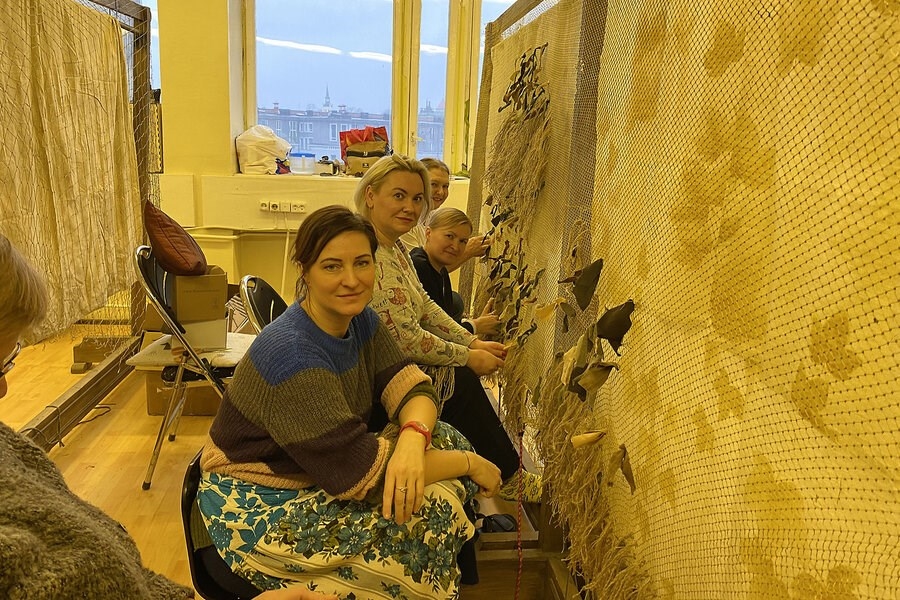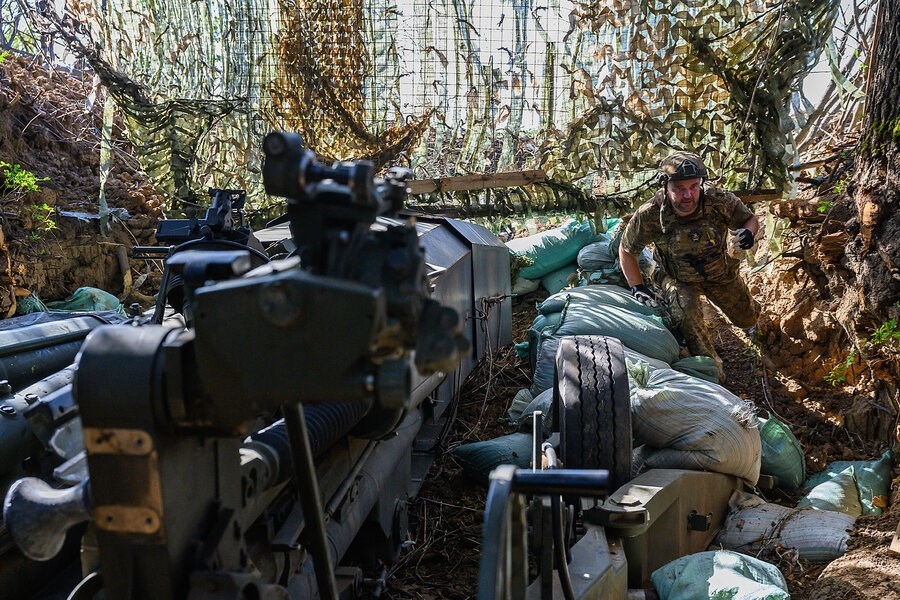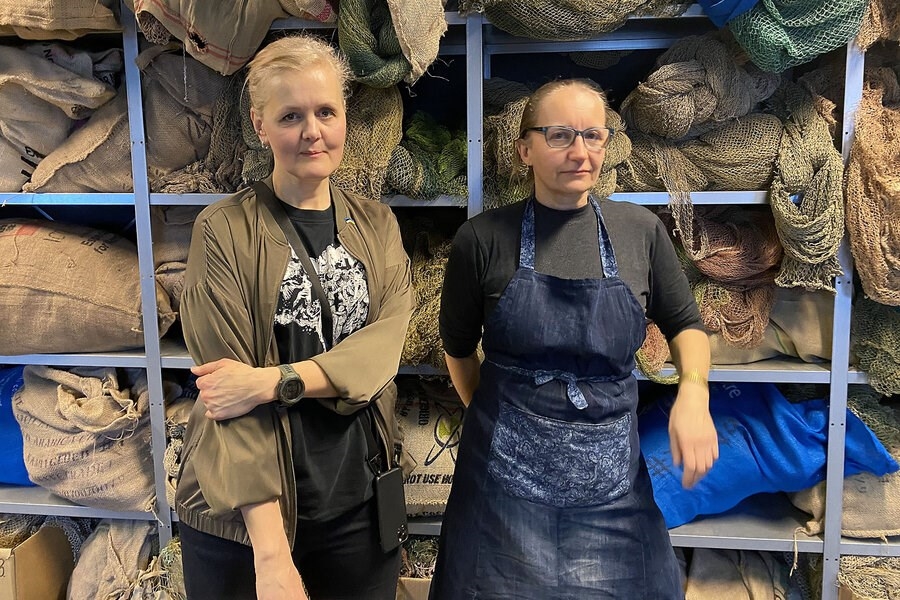REPRINTED WITH PERMISSION FROM THE CHRISTIAN SCIENCE MONITOR
In tiny Estonia, where memories of living under Soviet rule still linger, volunteers are finding purpose in weaving camouflage nets for Ukraine’s front-line fighters, to protect them against Russian attack.
 Natalya Kubenko (rear center) fled Ukraine to resettle in Tallinn, Estonia. She says that she has found friends and purpose through weaving camouflage nets for Ukrainian forces. Lenora Chu
Natalya Kubenko (rear center) fled Ukraine to resettle in Tallinn, Estonia. She says that she has found friends and purpose through weaving camouflage nets for Ukrainian forces. Lenora Chu
| TALLINN, ESTONIA
After Russia invaded her home country of Ukraine, Natalya Kubenko fled to this Baltic capital, and found herself depressed and anxious. “I watched the news every day, and for the first eight months, I did not want to live,” she says.
Ms. Kubenko found healing via a twice-weekly pastime: hand-weaving camouflage nets to send to the front lines in Ukraine. Meeting like-minded volunteers gave Ms. Kubenko a community – and a purpose.
“Here there are Ukrainians, Estonians, a few Russians who support us. I came here and found a new family for me. It became easier to live here,” says Ms. Kubenko, who fled Bila Tserkva, a city 80 kilometers (50 miles) outside Kyiv.
Now, most Tuesdays and Wednesdays, she travels to an old office building in downtown Tallinn, to join fellow volunteers at the nonprofit Aitan Kaitsta, which means “I help to defend.” The mostly female group spends hours hand-tying scraps of discarded clothing to industrial fishing nets. Their handiwork will eventually morph into camouflage nets, which will help shield Ukrainian tanks, military equipment, trenches, and snipers from being spotted by Russian drones and guided missiles.
Now Aitan Kaitsta has 18 locations across Estonia, operating on a shoestring budget, in donated space, and with discarded clothing and fishing nets. Over the last two years they’ve sent several football fields’ worth of nets to Ukraine. Volunteer efforts like theirs have been critical to assisting Ukraine’s military, says Kusti Salm, permanent secretary of the Estonian Ministry of Defense.
“The Russians get aerial pictures, and if you have covered your unit, machines, vehicles, and even kitchens, they cannot see it from the sky,” says Mr. Salm. “The utility of that is extremely high; it’s nonlethal ... and something that everyone can do. It’s of course a lot of time and effort. But, you know, I don’t think that there is a single family that hasn’t donated something to Ukraine.”
 Scott Peterson/Getty Images/The Christian Science MonitorUkrainian armed forces gunners, defending themselves against Russian forces, use a camouflage net to hide their gun from reconnaissance drones.
Scott Peterson/Getty Images/The Christian Science MonitorUkrainian armed forces gunners, defending themselves against Russian forces, use a camouflage net to hide their gun from reconnaissance drones.At the Tallinn location, volunteers gather in a large space fringed with fabric scraps in the hues of nature: woody greens, dark browns, light tans. The place looks like an indoor forest. Some cut clothing into long pieces, while others weave the strips onto nets.
Anu Lensment, one of the group’s co-founders, says the work is a source of therapy during a time of war. “It’s easier to act, to move, than to sit still and hope it will be OK,” she says.
It’s an all-volunteer effort for a critical piece of military defense, and the handmade versions are superior to the machine-made kinds, which are more uniform and more easily detected by the enemy.
“The Ukrainians are keeping the war there and we have to help,” says Ms. Lensment, who works as a costume designer and has clothed the Estonian first lady. “These kinds of things really help there. This isn’t just a nice blanket – really it’s saving lives and millions [of euros’ worth] of military equipment.”
“Sometimes we get orders from Ukraine, and we have to make them very quickly,” says Jaana Ratas, an archaeologist and textile conservationist by trade, and the other co-founder of the group. The women sometimes receive photos from military contacts to illustrate how the landscape changes over time. “Is it spring? Which colors are in nature? We have very good consultants such as snipers who have given us very good advice.”
 Lenora ChuAnu Leesment (left) and Jaana Ratas co-founded the nonprofit Altan Kaitsta, which organizes volunteers to weave camouflage nets to send to the front lines in Ukraine.
Lenora ChuAnu Leesment (left) and Jaana Ratas co-founded the nonprofit Altan Kaitsta, which organizes volunteers to weave camouflage nets to send to the front lines in Ukraine.
Camouflage nets can even change the appearance of smaller buildings, says Marek Kohv, a security expert at Estonia’s International Centre for Defence and Security. “They can also cover the lines of trenches, so that drones don’t see them,” he says.
The volunteers’ work is mission-critical. “They say 80% of success on the front line depends on the support from the rear,” says Ms. Ratas. “You can’t do everything when you’re a fighter. You need somebody feeding you, somebody bringing you ammunition, somebody dressing you.”
For the co-founders, the work is punctuated by memories of living through Soviet times. Both Ms. Ratas and Ms. Lensment were teenagers when Estonia gained independence from the Soviet Union in 1991; Ms. Lensment’s grandmother had been sent to Siberia during the 1949 Stalin-ordered mass deportation of people from the Baltic states, and one of her grandfathers served in World War II. During her own teenage years under Soviet rule, Ms. Ratas remembers lacking toilet paper and menstrual pads, and having to be very careful with whom she shared thoughts critical of the government.
They never forgot the “nervousness” of those times. “We have had ... freedom and peaceful times” since then, “but there’s always this feeling that something can happen,” says Ms. Lensment. “If it happens here, it will be totally different from Ukraine, because Estonia is so small.”
“We have our own history with Russia, and we can’t even imagine not doing anything. It’s so natural,” says Ms. Ratas. “If you see that somebody’s being bullied, then you need to go and help.”
The women have pulled together instruction booklets to standardize the net-making process, and translated them into four languages – English, Finnish, Ukrainian, and Estonian. Should Russia invade, both women have also quietly forged plans to send their children out of Estonia while they stay and fight.
Mr. Salm, at the Defense Ministry, commends their efforts and explains that the spirit of volunteerism is something that’s ingrained in the Estonian consciousness, in part because it’s a small country that wouldn’t function well otherwise.
“This tradition goes back to the first independence time during the ’20s and ’30s, and we reconstituted it after regaining independence,” says Mr. Salm. “And if you don’t have meaningful resources, you can contribute time and you can make a huge effort and impact.”
Page created on 9/2/2024 3:38:02 PM
Last edited 9/2/2024 3:47:50 PM
